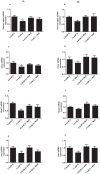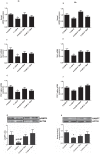Involvement of the clock gene Rev-erb alpha in the regulation of glucagon secretion in pancreatic alpha-cells
- PMID: 23936124
- PMCID: PMC3723646
- DOI: 10.1371/journal.pone.0069939
Involvement of the clock gene Rev-erb alpha in the regulation of glucagon secretion in pancreatic alpha-cells
Abstract
Disruption of pancreatic clock genes impairs pancreatic beta-cell function, leading to the onset of diabetes. Despite the importance of pancreatic alpha-cells in the regulation of glucose homeostasis and in diabetes pathophysiology, nothing is known about the role of clock genes in these cells. Here, we identify the clock gene Rev-erb alpha as a new intracellular regulator of glucagon secretion. Rev-erb alpha down-regulation by siRNA (60-70% inhibition) in alphaTC1-9 cells inhibited low-glucose induced glucagon secretion (p<0.05) and led to a decrease in key genes of the exocytotic machinery. The Rev-erb alpha agonist GSK4112 increased glucagon secretion (1.6 fold) and intracellular calcium signals in alphaTC1-9 cells and mouse primary alpha-cells, whereas the Rev-erb alpha antagonist SR8278 produced the opposite effect. At 0.5 mM glucose, alphaTC1-9 cells exhibited intrinsic circadian Rev-erb alpha expression oscillations that were inhibited by 11 mM glucose. In mouse primary alpha-cells, glucose induced similar effects (p<0.001). High glucose inhibited key genes controlled by AMPK such as Nampt, Sirt1 and PGC-1 alpha in alphaTC1-9 cells (p<0.05). AMPK activation by metformin completely reversed the inhibitory effect of glucose on Nampt-Sirt1-PGC-1 alpha and Rev-erb alpha. Nampt inhibition decreased Sirt1, PGC-1 alpha and Rev-erb alpha mRNA expression (p<0.01) and glucagon release (p<0.05). These findings identify Rev-erb alpha as a new intracellular regulator of glucagon secretion via AMPK/Nampt/Sirt1 pathway.
Conflict of interest statement
Figures








Similar articles
-
AMP-activated protein kinase regulates glucagon secretion from mouse pancreatic alpha cells.Diabetologia. 2011 Jan;54(1):125-34. doi: 10.1007/s00125-010-1929-z. Epub 2010 Oct 13. Diabetologia. 2011. PMID: 20938634 Free PMC article.
-
Integration of the nuclear receptor REV-ERBα linked with circadian oscillators in the expressions of Alas1, Ppargc1a, and Il6 genes in rat granulosa cells.Chronobiol Int. 2015;32(6):739-49. doi: 10.3109/07420528.2015.1042582. Epub 2015 Jun 23. Chronobiol Int. 2015. PMID: 26102301
-
Identification of SR8278, a synthetic antagonist of the nuclear heme receptor REV-ERB.ACS Chem Biol. 2011 Feb 18;6(2):131-4. doi: 10.1021/cb1002575. Epub 2010 Nov 10. ACS Chem Biol. 2011. PMID: 21043485 Free PMC article.
-
Role of the clock gene Rev-erbα in metabolism and in the endocrine pancreas.Diabetes Obes Metab. 2015 Sep;17 Suppl 1:106-14. doi: 10.1111/dom.12522. Diabetes Obes Metab. 2015. PMID: 26332975 Review.
-
Role of Circadian Transcription Factor Rev-Erb in Metabolism and Tissue Fibrosis.Int J Mol Sci. 2022 Oct 26;23(21):12954. doi: 10.3390/ijms232112954. Int J Mol Sci. 2022. PMID: 36361737 Free PMC article. Review.
Cited by
-
Rev-erbα and the circadian transcriptional regulation of metabolism.Diabetes Obes Metab. 2015 Sep;17 Suppl 1(0 1):12-6. doi: 10.1111/dom.12510. Diabetes Obes Metab. 2015. PMID: 26332963 Free PMC article. Review.
-
A trio of biological rhythms and their relevance in rhythmic mechanical stimulation of cell cultures.Front Psychol. 2022 Jul 29;13:867191. doi: 10.3389/fpsyg.2022.867191. eCollection 2022. Front Psychol. 2022. PMID: 35967633 Free PMC article.
-
The effect of diurnal variation on the performance of exhaustive continuous and alternated-intensity cycling exercises.PLoS One. 2020 Dec 31;15(12):e0244191. doi: 10.1371/journal.pone.0244191. eCollection 2020. PLoS One. 2020. PMID: 33382736 Free PMC article.
-
Circadian metabolism in the light of evolution.Endocr Rev. 2015 Jun;36(3):289-304. doi: 10.1210/er.2015-1007. Epub 2015 Apr 30. Endocr Rev. 2015. PMID: 25927923 Free PMC article. Review.
-
International Union of Basic and Clinical Pharmacology CXIII: Nuclear Receptor Superfamily-Update 2023.Pharmacol Rev. 2023 Nov;75(6):1233-1318. doi: 10.1124/pharmrev.121.000436. Epub 2023 Aug 16. Pharmacol Rev. 2023. PMID: 37586884 Free PMC article. Review.
References
-
- Muhlbauer E, Wolgast S, Finckh U, Peschke D, Peschke E (2004) Indication of circadian oscillations in the rat pancreas. FEBS Lett 564: 91–96. - PubMed
-
- Panda S, Antoch MP, Miller BH, Su AI, Schook AB, et al. (2002) Coordinated transcription of key pathways in the mouse by the circadian clock. Cell 109: 307–320. - PubMed
-
- Vieira E, Nilsson EC, Nerstedt A, Ormestad M, Long YC, et al. (2008) Relationship between AMPK and the transcriptional balance of clock-related genes in skeletal muscle. Am J Physiol Endocrinol Metab 295: E1032–1037. - PubMed
Publication types
MeSH terms
Substances
Grants and funding
LinkOut - more resources
Full Text Sources
Other Literature Sources
Molecular Biology Databases
Miscellaneous

